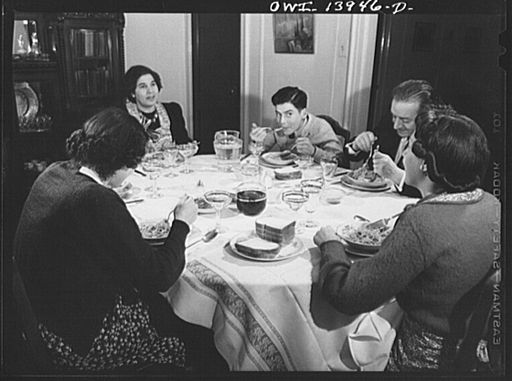2.2: The Capacity for Culture
- Last updated
- Save as PDF
- Page ID
- 56360
SOCIETY AND CULTURE
One aspect of life that humans and animals have in common is that we live in organized groups, or a society. But do we share culture? Once upon a time, social scientists regarded humans as the only species to exhibit culture. But if language and tool use are both evidence of culture, we must acknowledge that other species may also possess some rudiments of culture. Whales and dolphins, for instance, may have some capacity for language. And chimpanzees have been observed making tools, “fishing rods” so to speak, for retrieving termites from their nests. Bottle-nosed dolphins also appear to be tool-users. They have been observed to break off pieces of sea sponge and use them in order to probe for fish along the sea bottom. Ethologists have even observed that some species of songbirds, and some species of fish too, exhibit “socially learned cultural traditions” (Mesoudi 2011).
Definition: society
Organized life in groups.
While there is evidence that non-human primates and other species do learn and share some type of culture, no other species demonstrates the cultural virtuosity of human beings. For one thing, the cultures of non-human species do not seem to show the same tendencies of development and innovation from one generation to the next, as human culture does. For example, the combining of two or more separate elements into entirely new tools or practices does not seem to occur among non-humans, whereas it is a hallmark of human cultural development.
Interactive Element
Quartz. (2017, December 7). Inside our quest to talk to dolphins. [YouTube]. Retrieved from https://youtu.be/f-QjrTaypw0.
Cell Press. (2020, June 25). Dolphins Learn Foraging Skill "Shelling" from Peers. [YouTube]. Retrieved from https://youtu.be/f9nc3-pz7Tc.
Enculturation
Tylor's definition of culture included shared beliefs, art, law, morals, custom, capabilities, and habits. Boas and his students added to this definition by emphasizing the importance of enculturation, the process of learning culture, in the lives of individuals. Benedict, Mead, and others established that, through the process of enculturation, culture shapes individual identity, self-awareness, and emotions in fundamental ways. Although parents and other authority figures in a young child's life are usually the initiators of this process, people in the community also play a part in steering children toward activities and beliefs that will be socially accepted in their culture. Through this process, the individuals in the child's life shape their worldview. Clifford Geertz (1973) proposed that a society's culture is a "set of control mechanisms--plans, recipes, rules, instructions what computer engineers call programs, for governing behaviors" (44). It is through conscious and unconscious learning, interaction, and observation that individuals acquire the rules of the culture they live in.
Definition: enculturation
The process of learning culture.
It is important to understand the role that enculturation plays in maintaining the beliefs and practices of a culture as well as the role it plays in our individual thought patterns. Enculturation affects how we view other cultures and their practices, which can lead to ethnocentrism (discussed later in this chapter). For example, in the United States, we are taught to eat with forks, knives, and spoons; however, in some cultures, especially in the Middle East and Asia, eating with your hands from a common dish is perfectly acceptable...and expected. Likewise, some countries drive on the left side of the road, while others, like the United States, drive on the right side. Often, we may hear the comment, "They drive on the wrong side of the road!". Obviously, there is no right or wrong side of the road just as there is no right or wrong way to eat food. However, there are other cultural rules that one must learn for each practice.


Image 1: Qurutob: eating the traditional way with one's hands, 2007, by Zlerman under CC BY-SA 3.0.
Image 2: Corona, Long Island, New York Family Eating Supper, 1943, by Marjory Collins under Public Domain.
Shared Culture
Humans share both material and non-material culture. Material culture consists of tangible objects that people create: tools, toys, buildings, furniture, images, and even print and digital media—a seemingly endless list of items. As discussed in chapter 1, archeologists study the material culture from societies as remote in time as the Upper Paleolithic (and earlier) which tells us a lot about their activities. In fact, material culture is almost all we have to inform us about human culture in the deep past before the existence of written records. While material culture provides clues about the lives of the people who create and use it, artifacts alone are silent about many other details of past cultures, for much of human culture is non-material.
Non-material culture includes such things as: beliefs, practices, customs, traditions, and rituals, to give just a few examples. As discussed earlier in this chapter, beliefs are the mental aspects of a culture that includes norms and values. While some beliefs may be universally shared across most cultures, culturally shared beliefs tend to have boundaries. The members of one group may consider their own, shared cultural beliefs as self-evidently true, while members of other groups might consider the same beliefs as questionable, if not strange and arbitrary. Culturally relevant beliefs govern every conceivable aspect of social life: religious, political, economic, and domestic to mention only a few.
Norms
Norms are the expectations or rules, formal or informal, about what is considered appropriate or inappropriate behavior in a particular society. Generally, norms are separated into two types: folkways and mores. Folkways are a loose collection of usual or customary ways in which the members of a particular cultural community behave. Examples include: how people greet one another, how they dress, what they eat, how they prepare it, and how they eat it, how they handle interpersonal conflict, etc. Mores (pronounced “more-rays”) are stricter than folkways. They are the standards of moral conduct and ethical behavior that the people in a cultural community expect of one another. They include such things as rules against killing, rules about who can or cannot have sex with whom, and so on.
Definition: norms
The expectations or rules, formal or informal, about what is considered appropriate or inappropriate behavior in a particular society.
Definition: folkways
A loose collection of usual or customary ways in which the members of a particular cultural community behave.
Definition: mores
The standards of moral conduct and ethical behavior that the people in a cultural community expect of one another; what a community considers morally or ethically right or wrong.
The mores of a society are enforced in various ways. The most important mores are upheld by means of laws, which are explicitly stated rules that are enforced. People who violate laws may have to pay a penalty, for example, going to jail, or paying a monetary fine. Other mores may not be strictly against the law but are nevertheless strongly endorsed by a society. Such mores may be upheld mainly by means of social sanctions, which are ways of communicating disapproval or putting pressure on people who violate a community’s mores. For example, people who violate mores for which there are no formal laws may find that the people of a community make life uncomfortable for them. The community may publicly condemn the person (shaming) or avoid interacting with the person (shunning).
Definition: laws
Explicitly stated rules that are enforced.
Definition: social sanctions
Ways of communicating disapproval or putting pressure on people who violate a community’s mores.
One way to look at the difference between folkways and mores is to say that folkways reflect what a cultural community regards as appropriate or inappropriate, polite or rude. Mores, however, reflect what a community considers as morally or ethically right or wrong.
Values
Cultural values are closely associated with both the beliefs and norms of a cultural community. Values can be defined as the symbolic, abstract concepts or standards that represent the ideals of a group. They point to what the group most regards as right, good, beautiful, desirable, etc. Values are often identified in discourse by means of words or phrases, e.g., “freedom,” “equality,” “filial piety,” “respect for elders.” Values, though, go hand in hand with beliefs. Think of a value, when articulated, as a shorthand way of referring to a belief. But of course, a value is hardly a value unless it is acted upon. In other words, we generally think of a value as a guide to conduct.
Definition: values
The symbolic, abstract concepts or standards that represent the ideals of a group.
What purpose do values serve? – we might want to ask. For one thing, shared cultural values may help promote group cohesion. They encourage group members to behave in ways that the group considers appropriate, proper, honorable, praiseworthy, and the like. As is true also with beliefs and norms though, not everyone necessarily adheres to the widely shared values of a culture to the same degree, and sometimes not at all. In fact, some cultural values may even be in conflict with other values.
Customs and Traditions
Customs and traditions are two more aspects of non-material culture. A custom is a widely accepted way of doing something, specific to a particular society that has developed through repetition over a long period of time. A tradition, as defined by David Gross (1992), is “a set of practices, a constellation of beliefs, or mode of thinking that exists in the present, but was inherited from the past" (8). Gross further elaborates, writing that a tradition “can be a set of observances, a collection of doctrines or teachings, a particular type of behavior, a way of thinking about the world or oneself, a way of regarding others or interpreting reality.”
Definition: custom
A widely accepted way of doing something, specific to a particular society that has developed through repetition over a long period of time.
Definition: tradition
A set of practices, a constellation of beliefs, or mode of thinking that exists in the present, but was inherited from the past.
Gross (1992) acknowledges that customs and traditions have much in common and that therefore the differences between them are easily blurred. He insists, however, that from the perspective of society as a whole, customs are less important than traditions. Compared with traditions, Gross claims, customs involve “mostly superficial modes of behavior” that “are not as heavily invested with value.” For example, says Gross, long-standing forms of greeting, like bowing in Japan, or shaking hands in the U.S. are “relatively insignificant social habits,” better characterized as customs than as traditions. Still, Gross admits, “the boundary separating custom from tradition is not always easy to discern” (12).
BIBLIOGRAPHY
Geertz, Clifford. The Interpretation Of Cultures. United Kingdom: Basic Books, 1973.
Gross, D. The past in ruins. Amherst, MA: University of Massachusetts Press, 1992.
Mesoudi, A. Cultural evolution: How Darwinian evolution can explain human evolution and synthesize the social sciences. Chicago: University of Chicago Press, 2011.
Derived From
"Introduction to Anthropology" by Braff, L. & Nelson, K. In Perspectives: An Open Invitation to Cultural Anthropology. Society for Anthropology in Community Colleges, 2020, under CC BY-NC 4.0.
"Chapter 3: Origins and Early Developments of Culture" in Speaking of Culture by Nolan Weil under CC BY-NC 4.0.

